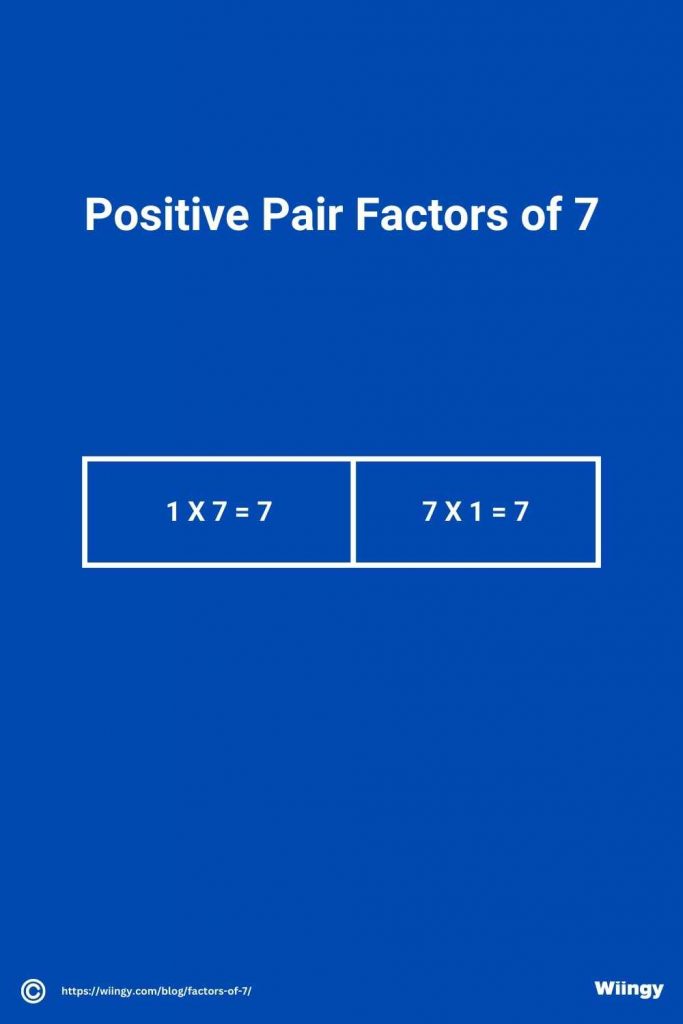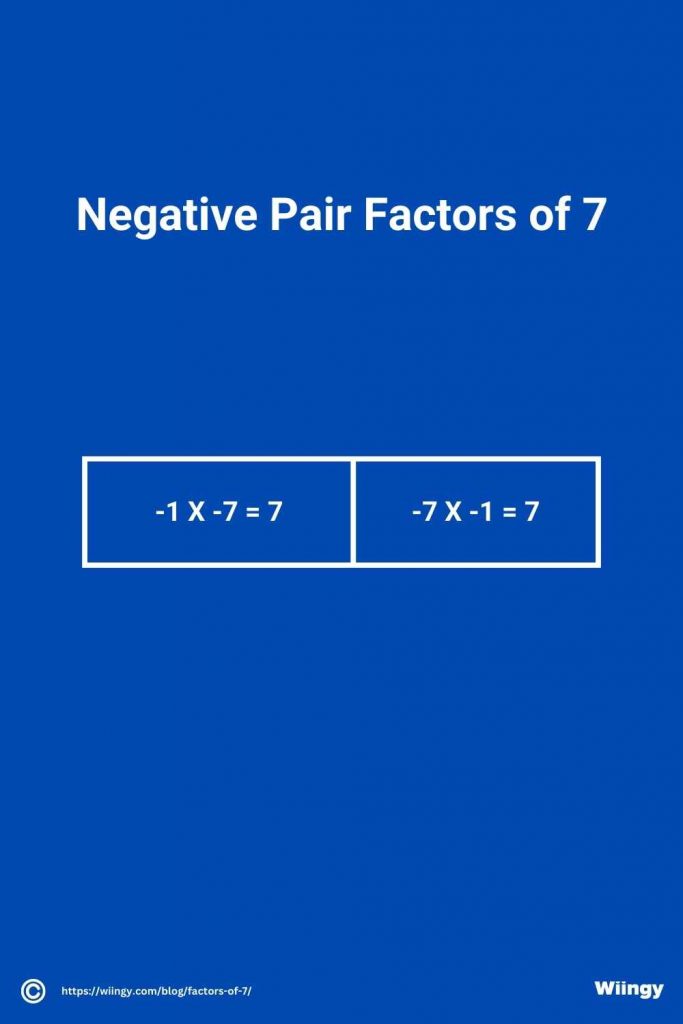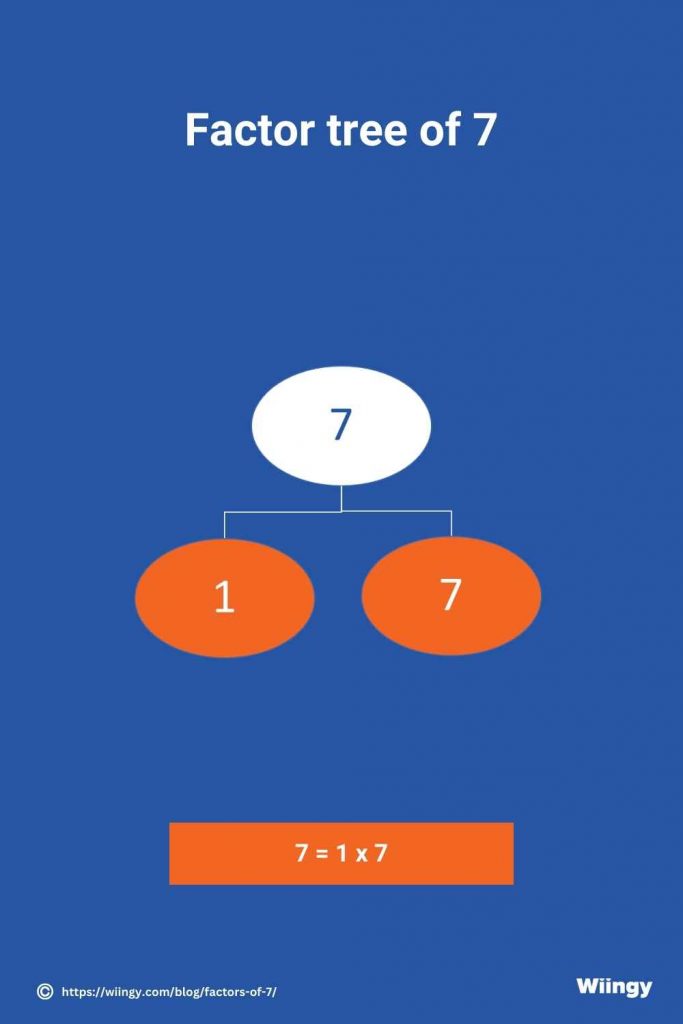Factors of 7 | Prime Factorization of 7 | Factor Tree of 7
Written by Prerit Jain
Updated on: 15 Feb 2023
Contents
Factors of 7 | Prime Factorization of 7 | Factor Tree of 7
Factors of 7: Factors of a number are those which can divide the given number evenly. They leave behind no remainder. 7 is a prime number. So, it has only two factors that can divide it evenly. These factors are 1 and 7.
All numbers have pair factors that are positive and negative. So, multiplying the set of two factors in pairs gives the original product. We will find the factors of 7 in this article. We will also learn about its prime factorization, and factor trees with examples. Keep reading to learn more.
What Are the Factors of 7?
The factors of 7 are the numbers that divide it evenly without leaving a remainder. These factors can be positive and negative. Hence, the number 7 has both positive and negative factors.
| Factors of 7: 1 and 7. |
| Negative Factors of 7: -1 and -7 |
| Prime Factorization of 7: 1 X 7 |
| Pair Factors of 7: (1, 7) |
| Prime Factors of 7: 7 |
| Sum of Factors of 7: 8 |
| Sum of Prime Factors of 7: 7 |
What Are the Factors of 7 in Pairs?
A pair factor of 7 is a combination of two numbers when multiplied yields the product of the original number. These pair factors are also written in positive and negative pairs as shown in the table below:
Positive Pair Factors of 7
The positive pair factors of 7 are (1, 7).

Negative Pair Factors of 7
The negative pair factors of 7 are (-1, -7).

How To Find Factors of 7 Through Division Method?
We are going to use the division method to determine the factors of 7. The numbers that divide 7 completely, without leaving any reminders are entered sequentially and tested, to see the result. The following are the detailed steps to find the factors of 7:
• 7 ÷ 1 = 7
• 7 ÷ 7 = 1
Therefore, we can see that 1 and 7 are the numbers that do not leave any remainder when divided by 7, so they are its factors.
What Is the Prime Factorization of 7?
The prime factorization of a number is the product of its factors, which are prime. Now let’s discuss the process of finding the prime factors of 7.
- The factors of 7 are 1 and 7. Now, let’s check if the numbers in the pair factor of the number 7 are prime numbers or composite numbers. If a number in the pair factor is a prime number, then you can leave it as it is as you cannot split it any further. If a number in the pair factor is a composite number, it can be split into its prime factors.
- Now, in the pair factors of 7, we know that 1 is neither a prime number nor a composite number, so it cannot be split further.
- 17, which is already a prime number and cannot be split further.
- Hence, 17 can be written as the product of 1 and 7, i.e., 7 X 1 = 7.
- Therefore, the prime factorization of the number 7 is 7.
Image representation of the prime factorization of 7:

What is the Factor Tree of 7?
The steps to find a factor tree of 7 is given below:
- Step 1: Firstly, write the number 7 at the top of the factor tree.
- Step 2: Now, as a part of the tree’s branches, write down the pair factor of 7. The pair factor pair of 7 is 1 and 7.
- Step 3: Since 1 is neither a prime nor a composite number, it cannot be spilt further, and 17 is already a prime number, so it cannot be split further.

Solved Examples
Example 1: Determine the common factors shared by 21, 14, and 7.
Solution:
1, 3, 7, and 21 are the factors of integer 21.
1, 2, 7, and 14 are the factors of the integer 14.
1, and 7 are the factors of the integer 7.
Since 1 and 7 are the only two numbers that divide all the three integers 7, 14, and 21 without actually leaving a residue. Therefore the common factors of 21, 14, and 7 are 1 and 7.
Example 2: Examine the total number of integers that could divide by 7 equally.
Solution:
7 could be equally divided by only two integers, 1 and 7. Dividing 7 with any other integer with produce a residue.
Hence, 7 has only 2 factors.
Example 3: Multiply all the prime factors of 7 to determine the product.
Solution:
1 and 7 are the only prime factors of 7.
Product of prime factors of 7 = 1 × 7
= 7.
So, on multiplying all the prime factors of 7 the product obtained is 7.
Example 4: Mira bought 7 apples she intends to distribute them equally among her three friends. If any apples are left behind, she would consume them herself. Will she end up having any of the apples?
Solution:
Total number of apples bought = 7
Number of children = 3
73 = 2 and the remaining is 1
On dividing 7 by 3, we get the quotient as 2 and the remainder as 1. So, Mira can give 2 apples to each of her 3 children. After distributing between her children, she would be left with 1 apple to consume.
Therefore, Miranda will end up having 1 apple after distributing 6 equally between her 3 children.
Example 5: Can you assist Melvin in discovering all the positive pair factors of 7?
Solution:
(1, 7), (7, 1) are the only two positive pair factors of 7.
Since 7 has only two factors 1 and 7, which can be included in their positive factor pairs, hence no other number can be included in their positive factor pairs
Frequently Asked Questions
1. Whether 3 is a factor of 7?
No, 7 cannot be precisely divided by 3, since when you divide 7 by 3, you will be left with 1 as a residue, that is, 3 does not divide 7 exactly and is not a factor of 7.
2. What does the term “factor of 7” exactly mean?
The numbers that may divide 7 without leaving any residue but only zero are called the factors of 7.
3. Find the number obtained by adding all the factors of 7?
1 and 7 are the only two factors of 7.
Therefore, the sum of all the factors of 7 yield, 1+7 = 8
Hence, the number obtained on this addition is 8.
4. Whether 7 is a composite number?
1 and 7 are the only two factors of 7. No other integers are the factors of 7, since they can divide 7 without leaving a remainder. Because of this, 7 does not belong to the set of composite numbers; rather, it is a prime.
5. Can you identify the smallest and largest factors of 7?
There are only two factors that may be used to divide 7, those are 1 and 7. Accordingly, 1 is the least while 7 itself is the greatest factor of 7.
Written by by
Prerit Jain
